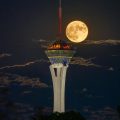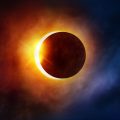
Tonight, skywatchers across the globe are in for a treat as a supermoon graces the night sky. This astronomical event occurs when the full moon coincides with the moon’s closest approach to Earth in its orbit, known as perigee. Here’s everything you need to know about this celestial phenomenon and how to best observe it.
What is a Supermoon?
A supermoon is not just any full moon; it’s when the full moon happens to align with the moon being at or near its perigee. Unlike the term’s astrological origins coined by Richard Nolle in 1979, where he defined it within 90% of perigee, for most astronomical purposes, a supermoon is when the moon is at its closest to Earth, making it appear larger and brighter than usual.
- Size and Brightness: During a supermoon, the moon can appear up to 14% larger and 30% brighter compared to when it’s at apogee, its furthest point from Earth. This might seem like a small difference, but when viewed near the horizon or with the right conditions, the effect can be quite noticeable.
- Frequency: Supermoons are not exceedingly rare, with several occurring each year due to the elliptical nature of the moon’s orbit around Earth.
Tonight’s Supermoon: The Beaver Moon
Tonight’s supermoon is particularly noteworthy as it’s the final supermoon of 2024, commonly referred to as the Beaver Moon. This name traditionally stems from the time when beavers begin to take shelter in their lodges for the winter, as noted by Native American, Colonial, and European sources.
- Date and Time: The peak illumination of this supermoon occurs today, November 15, 2024, around 5:52 PM PST (depending on your local time, this could be early evening or night elsewhere).
- Why It’s Special: This supermoon is the fourth in a series of consecutive supermoons, a phenomenon not uncommon but always spectacular. The moon will be approximately 224,853 miles (361,866 kilometers) from Earth, closer than an average full moon.
Tips for Viewing the Supermoon
- Find Your Spot Early:
- Locate a spot with a clear view towards the east for moonrise. This will give you the best chance to see the moon when it appears larger due to the Moon Illusion phenomenon, where the moon looks bigger on the horizon.
- Timing is Everything:
- Aim to watch the moonrise just after sunset or the moonset before sunrise. These times allow the moon to be seen in a dark sky with less light pollution, enhancing its visibility.
- Escape Light Pollution:
- If possible, head to areas with minimal artificial light. Rural locations or designated dark sky parks are ideal for unobstructed and clear views.
- Photography Tips:
- Use a Tripod: Stability is key for sharp images.
- Camera Settings: Use a low ISO to reduce noise, a fast shutter speed if hand-held, but slower speeds with a tripod for detail. A telephoto lens will bring the moon closer, but wide-angle shots with foreground elements can capture the Moon Illusion.
- Manual Focus: Autofocus might struggle with the moon; manual focus or live view zoom can help.
- No Equipment? No Problem:
- While binoculars or telescopes can offer a closer view of the moon’s surface, the supermoon is a naked-eye event. Its brightness and size are visible without any equipment.
- Weather Watch:
- Check local weather forecasts. Clear skies are crucial. While some cloud cover can create dramatic photos, too much can obscure the view entirely.
- Plan for the Whole Night:
- The supermoon will be visible throughout the night, but its position changes. Watching its journey across the sky can be rewarding, especially if you aim to photograph it at different points.
- Cultural and Educational Aspect:
- Use this opportunity to learn or teach about lunar phases, the moon’s orbit, and cultural tales associated with the full moon.
Conclusion
Tonight’s supermoon, the Beaver Moon, offers an excellent chance for both seasoned astronomers and casual observers to witness one of nature’s most beautiful displays. Whether you’re capturing it through a lens or simply enjoying its glow with the naked eye, remember to take in not just the spectacle but also the wonder of our closest celestial neighbor’s dance with Earth. Enjoy this natural phenomenon, and let it remind us of the vast, mysterious universe we are a part of.








